A. PHONETICS
Task 1. Complete the words under the pictures, using the correct spellings for the sounds /sk/, /sp/, and /st/. Then read the words aloud.
(Hoàn thành các từ dưới bức tranh, sử dụng cách đánh vần đúng cho các âm /sk/, /sp/ và /st/. Rồi đọc to các từ.)
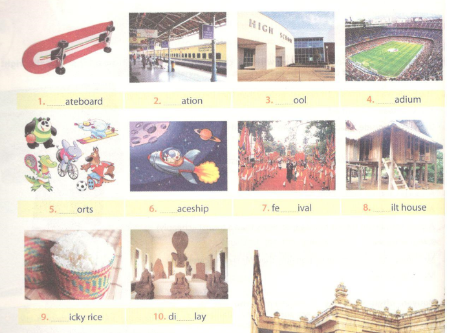
Lời giải chi tiết:
1. skateboard /ˈskeɪt.bɔːd/ (ván trượt)
2. station /ˈsteɪ.ʃən/ (ga, trạm)
3. school /skuːl/ (trường học)
4. stadium /ˈsteɪ.di.əm/ (sân vận động)
5. sports /spɔːt/ (thể thao)
6. spaceship /ˈspeɪs.ʃɪp/ (tàu không gian)
7. festival /ˈfes.tɪ.vəl/ (lễ hội)
8. stilt house /stɪlts haʊs/ (nhà sàn)
9. sticky rice /ˌstɪk.i ˈraɪs/ (bánh chưng)
10. display /dɪˈspleɪ/ (triển lãm)
Bài 2
Task 2. Underline the words with the sounds /sk/, /sp/, and /st/.Then read the sentences.
(Gạch chân các từ với âm /sk/, /sp/ và /st/. Đọc các câu.)
1. The items on display in Da Nang Museum of Cham Sculpture are very interesting.
2. Most ethnic peoples in Viet Nam speak their own languages.
3. Gathering and hunting still play an important role in the life of some ethnic peoples in the mountains.
4. In the Central Highlands, the biggest and tallest house in the village is the communal house.
5. The Hoa women have a special style of colourful dress.
Lời giải chi tiết:
1. The items on display in Da Nang Museum of Cham Sculpture are very interesting.
Tạm dịch: Những đồ vật được trưng bày ở Bảo tàng Điêu Khắc Chăm Đà Nẵng rất thú vị.
2. Most ethnic peoples in Viet Nam speak their own languages.
Tạm dịch: Hầu hết các dân tộc ở Việt Nam nói ngôn ngữ riêng của họ.
3. Gathering and hunting still play an important role in the life of some ethnic peoples in the mountains.
Tạm dịch: Tập trung và săn bắn vẫn đóng vai trò quan trọng trong cuộc sống của các dân tộc miền núi.
4. In the Central Highlands, the biggest and tallest house in the village is the communal house.
Tạm dịch: Ở Tây Nguyên, ngôi nhà cao nhất và to nhất là nhà sinh hoạt cộng đồng.
5. The Hoa women have a special style of colourful dress.
Tạm dịch: Phụ nữ người Hoa có kiểu váy sặc sỡ đặc biệt.
Task 1. Complete the sentences with the words and phrases in the box.
(Hoàn thành các câu với các từ và cụm từ trong hộp.)
1. The Yao people use ideograms of Chinese origin to write their _________.
2. The Museum of Ethnology has a huge _________ of items of cultural importance from different ethnic groups in Viet Nam.
3. The Thai have their own language, and they also have their own _________.
4. If you are interested in ethnic minority culture, you should really go to one of the _________ in the northern mountainous regions.
5. The Viet people have many traditional _________: weaving, carpentry, embroidery ... and their products are famous everywhere.
6. The schools in this region have done much to help children of _________.
7. Mua sap is a _________ dance of Muong people in the North West.
8. Five-coloured sticky rice is a _________ in many parts of Viet Nam.
Lời giải chi tiết:
| 1. language | 2. collection |
| 3. writing system | 4. festivals |
| 5. crafts | 6. ethnic minorities |
| 7. typical | 8. speciality |
1. The Yao people use ideograms of Chinese origin to write their language.
- language (ngôn ngữ)
Tạm dịch: Người Yao sử dụng chữ tượng hình gốc Trung Quốc để viết ngôn ngữ của họ.
2. The Museum of Ethnology has a huge collection of items of cultural importance from different ethnic groups in Viet Nam.
- collection (bộ sưu tập/tập hợp)
Tạm dịch: Bảo tàng dân tộc học có một bộ sưu tập lớn những đồ vật có giá trị văn hóa to lớn từ các dân tộc thiểu số của Việt Nam.
3. The Thai have their own language, and they also have their own writing system.
- writing system (hệ thống chữ viết)
Tạm dịch: Người Thái có ngôn ngữ riêng của họ. Họ cũng có hệ thống chữ viết riêng.
4. If you are interested in ethnic minority culture, you should really go to one of the festivals in the northern mountainous regions.
- festival (lễ hội)
Tạm dịch: Nếu bạn có hứng thú với nền ăn hóa của các dân tộc thiểu số, bạn nên đến một lễ hội ở vùng núi phía Bắc.
5. The Viet people have many traditional crafts: weaving, carpentry, embroidery ... and their products are famous everywhere.
- crafts (đồ thủ công)
Tạm dịch: Người Việt có rất nhiều mặt hàng thủ công mĩ nghệ như đồ dệt may, đồ gỗ, đồ thêu,.. những sản phẩm này nổi tiếng khắp mọi nơi.
6. The schools in this region have done much to help children of ethnic minorities.
- ethnic minorities (dân tộc thiểu số)
Tạm dịch: Các trường học ở khu vục này đã thực hiện nhiều biện pháp để giúp đỡ trẻ em ở các dân tộc thiểu số.
7. Mua sap is a typical dance of Muong people in the North West.
- typical (điển hình)
Tạm dịch:Múa sạp là một điệu múa đặc trưng của người Mường ở phía Tây Bắc.
8. Five-coloured sticky rice is a speciality in many parts of Viet Nam.
- speciality (nét đặc trưng)
Tạm dịch: Xôi 5 màu là một nét đặc trưng của nhiều khu vực ở Việt Nam.
Bài 2
Task 2. Insert a question word to complete each of the following questions.
(Thêm một từ để hỏi để hoàn thiện các câu hỏi sau.)
- _________ of your parents will go to the meeting?
- My mother will.
- _________ colour is the Symbol of luck for the Hoa people?
- Red (is).
- _________ is a ‘long house’ of the Ede people?
- About 150 metres long.
- _________
- Women (do).
- _________ is the Hoa Ban Festival of the Thai people held?
- In Lunar February.
- _________ do the Odu people live?
- Mainly in Nghe An Province.
- _________ is it from the centre to the Museum of Ethnology?
- 15 about seven kilometres.
- _________ is this khan pieu (shawl)?
- Sorry, it's not for sale.
Lời giải chi tiết:
| 1. Which | 2. What |
| 3. How long | 4. Who |
| 5. When | 6. Where |
| 7. How far | 8. How much |
1. Which of your parents will go to the meeting?
Tạm dịch: Người nào trong bố mẹ em sẽ đi họp? – Mẹ em sẽ đi
2. What colour is the Symbol of luck for the Hoa people?
Tạm dịch: Màu nàu là biểu tượng của người Hoa – Màu đỏ
3. How long is a ‘long house’ of the Ede people?
Giải thích: How long+be+ S? = What+ be+ the length of+S?
Tạm dịch:Nhà dài của người Ê Đê dài bao nhiêu? – Khoảng 150 mét
4. Who plays a more important role in a Giarai family?
Giải thích: hỏi về người dùng Who
Tạm dịch: Ai đóng vai trò quan trọng hơn trong gia đình Gia Rai – Người phụ nữ
5. When is the Hoa Ban Festival of the Thai people held?
Giải thích: hỏi về thời gian dùng When
Tạm dịch: Khi nào đến lễ hội Hoa Ban của người Thái?
6. Where do the Odu people live?
Giải thích: hỏi nơi chốn dùng Where
Tạm dịch:Người Odu sống ở đâu? - Chủ yếu ở tỉnh Nghệ An
7. How far is it from the centre to the Museum of Ethnology?
Giải thích: cấu trúc hỏi về khoảng cách (How far is it from + N + to+ N?)
Tạm dịch:Từ trung tâm tới Bảo tàng Dân tộc học bao xa? – Khoảng 15 km
8. How much is this khan pieu (shawl)?
Giải thích: cấu trúc hỏi về giá cả (How much+be+N?)
Tạm dịch: Chiếc khăn piêu này giá bao nhiêu? – Xin lỗi, cái khăn này không bán
Bài 3
Task 3. Fill each blank with ‘a’, ‘an’, or ‘the’ to complete the following passage.
(Điền vào chỗ trống ‘a’, ‘an’ hoặc ‘the’ để hoàn thành đoạn văn sau.)
Y Moan was the greatest pop singer of the Ede ethnic group in Dak Lak Province. He was born in 1957 and died in 2010. He was called ‘(1) _________ singer of the great woods’. He is famous for singing songs about (2) _________ Central Highlands and the ethnic people there. In addition, he made (3) _________ important contribution, through his singing and his own songs, to making the Central Highlands well-known to millions of people both inside and outside (4) _________ country. He not only sang but also composed songs about the Central Highlands. He received (5) _________ lot of prizes and awards for his achievements in music. In 2010 he was given the title ‘People's Artist’, (6) _________ highest honour by the State for artists.
Lời giải chi tiết:
Y Moan was the greatest pop singer of the Ede ethnic group in Dak Lak Province. He was born in 1957 and died in 2010. He was called ‘the singer of the great woods’. He is famous for singing songs about the Central Highlands and the ethnic people there. In addition, he made an important contribution, through his singing and his own songs, to making the Central Highlands well-known to millions of people both inside and outside the country. He not only sang but also composed songs about the Central Highlands. He received a lot of prizes and awards for his achievements in music. In 2010 he was given the title ‘People's Artist’, the highest honour by the State for artists.
Giải thích
1. the
2. the
3. an (trước nguyên âm i trong từ important)
4. the
5. a (a lot of = lots of)
6. the (so sánh hơn nhất ''the most")
Tạm dịch
Y Moan là ca sĩ nhạc pop nổi tiếng nhất của dân tộc Ê Đê ở tỉnh Đắk Lắk. Ông sinh năm 1957 và mất năm 2010. Ông được mệnh danh là ‘Ca sĩ của rừng xanh’. Ông nổi tiếng bởi hát những bài hát về Tây Nguyên và người dân tộc ở đó. Bên cạnh đóm ông có những đóng góp quan trọng, thông qua tiếng hát và những bài hát của ông, để làm Tây Nguyên nổi tiếng với hàng triệu con người trong và ngoài nước. Ông không chỉ hát mà còn sáng tác những bài hát về Tây Nguyên. Ông nhận được rất nhiều giải thưởng cho sự nghiệp âm nhạc, Năm 2010, ông được trao giải Nghệ Sĩ Nhân Dân, giải thưởng cao quý nhất của nhà nước cho Nghệ Sĩ.
Bài 4
Task 4. Read each of the following lists of four words and choose one word that does not belong in each list.
(Đọc các danh sách có 4 từ sau và chọn một từ không thuộc nhóm.)
Lời giải chi tiết:
1. D (Vietnamese là người Việt Nam nói chung, các từ còn lại gọi tên các dân tộc ở Việt Nam)
2. A (costume là chỉ trang phục nói chung, các từ còn lại chỉ kiểu quần áo)
3. A (that dùng để chỉ, các từ còn lại dùng để hỏi)
4. B (minority là danh từ, các từ còn lại là tính từ)
5. C (scuptor là danh từ chung chỉ người, các từ còn lại là danh từ chung)
6. C (pizza không phải món ăn của người Việt)
Bài 5
Task 5. Choose the best answer to complete each of the following sentences.
(Chọn câu trả lời đúng nhất để hoàn thành các câu sau.)
Lời giải chi tiết:
1. No one is able to explain the ________ of the old customs.
A. beginning B. origin C. reason
- origin (n) nguồn gốc
Tạm dịch: Không ai có khả năng giải thích nguồn gốc của những truyền thống xa xưa
2. There are always regional ________ in every country.
A. differs B different C. differences
Giải thích: sau tính từ regional cần điền danh từ
Tạm dịch: Luôn có những khác biệt về tôn giáo ở mỗi đất nước.
3. ________ of your two sisters is studying in Australia?
A. Who B. What C.Which
- Who hỏi về người
Tạm dịch: Ai trong 2 chị của bạn học ở Úc?
4. Although there are cultural ________ between ethnic groups, they still keep the identity of their own culture.
Giải thích: cutural exchange: trao đổi văn hoá
A. changes B. exchanges C. relations
Tạm dịch:Dù có những trao đổi văn hóa giữa các dân tộc, họ vẫn giữ bản sắc văn hóa của mình.
5. The 54 ethnic peoples of Viet Nam are ________, but they live peacefully.
A. diverse B. similar C. unlike
- diverse (a) khác biệt
Tạm dịch:54 dân tộc Việt Nam có những khác biệt nhưng họ đều sống hòa bình.
6. Which ________ of our country would you most like to live in?
A. place B section C. part
- part: vùng
Tạm dịch:Vùng nào ở đất nước chúng tôi bạn thích sống nhất?
7. Most ethnic minority peoples are good ________ farming techniques
A. at B. for C. to
Giải thích: (be) good at + V-ing: giỏi về làm gì
Tạm dịch:Hầu hết các dân tộc thiểu số đều giỏi kĩ năng làm nông.
8. Chaul Chnam Thmey is the biggest ________ of the Khmer people.
A. Festival B. ceremony C. practice
- festival: lễ hội
Tạm dịch:Chaul Chnam Thmey là lễ hội lớn nhất của người Khmer
Bài 6
Task 6. Fill each blank with a suitable word to complete the passage.
(Điền vào chỗ trống một từ phù hợp để hoàn thiện đoạn văn.)
Hoang Ngoc Linh is a member of the Tay ethnic group in a mountainous (1) __________ in Bac Giang Province. She was born in 2003, and she goes to Cam Dan Lower Secondary School. In her class there are several students from other ethnic (2) __________ such as the Nung, the Cao Lan (Sanchay) and all of them get on very well. Like her classmates, she prefers to wear (3) __________ Kinh's clothes, and she wears a uniform when she goes to school. Linh loves to (4) __________ cartoons on TV and to play with her dolls. She can speak some words of the Tay (5) __________. At school, she is popular with her teachers and friends as she is a nice girl. She is good at maths and English. Her dream is to become (6) __________ English teacher when she grows up.
Lời giải chi tiết:
Hoang Ngoc Linh is a member of the Tay ethnic group in a mountainous region in Bac Giang Province. She was born in 2003, and she goes to Cam Dan Lower Secondary School. In her class there are several students from other ethnic groups such as the Nung, the Cao Lan (Sanchay) and all of them get on very well. Like her classmates, she prefers to wear the Kinh's clothes, and she wears a uniform when she goes to school. Linh loves to watch cartoons on TV and to play with her dolls. She can speak some words of the Tay language. At school, she is popular with her teachers and friends as she is a nice girl. She is good at maths and English. Her dream is to become an English teacher when she grows up.
Giải thích
1. region (n) :khu vực
2. groups ( cụm từ ethnic groups: nhóm dân tộc)
3. the
4. watch cartoon: xem hoạt hình
5. language (ngôn ngữ)
6. an
Tạm dịch
Hoàng Ngọc Linh là một thành viên của dân tộc Tày ở khu vực miền núi tỉnh Bắc Giang. Bạn ấy sinh năm 2003 và đến học trường THCS Cẩm Dàn. Trong lớp bạn ấy, có nhiều học sinh đến từ các dân tộc khác như người Nùng, người Cao Lan, ... và tất cả họ đều chơi hòa thuận với nhau. Như các học sinh cùng lớp, bạn ấy thích mặc đồ Kinh hơn, và bạn ấy mặc đồng phục khi bạn ấy đi học. Linh rất thích xem hoạt hình trên TV và chơi với búp bê. Bạn ấy có thể nói được vài từ tiếng Tày. Ở trường, bạn ấy rất được biết đến với giáo viên và bạn bè là một cô bé ngoan ngoãn. Bạn ấy giỏi Toán và Tiếng Anh. Giấc mơ của bạn ấy là trở thành một giáo viên tiếng Anh khi lớn lên.
Task 1. Talk with a partner. One is a reporter, the other is a foreigner and wants to know about ethnic groups of Viet Nam.
(Nói với bạn của em. Một người là phóng viên, một người là người nước ngoài muốn biết về dân tộc thiểu số ở Việt Nam.)
Example:
A: Hello. I'm from Australia. Can I ask you something about the ethnic groups of Viet Nam? (Xin chào. Tôi đến từ Úc. Tôi có thể hỏi bạn cái gì đó về dân tộc thiểu số ở Việt Nam không?)
B: Sure. (Chắc rồi)
A: What is the population of the largest ethnic group? (Dân số của dân tộc lớn nhất chỗ bạn là gì?)
B: About 74 million. It's the Viet or Kinh. (Khoảng 74 triệu người. Đó là người Việt hoặc Kinh.)
A: And what...? ( Và...)
You can use these cues:
- Which/ smallest ethnic group
- Odu group (about 370 inhabitants)
- Where/ the Churu/ mainly live
- Lam Dong Province —Wben/New Year/Lao ethnic group
- Lunar April
- What/ most important festival/ Viet people
- Tet (Lunar New Year)
- What/population/the Brau group
- About 400.
Lời giải chi tiết:
1.
- Which is the smallest ethnic group (in ỵour country)? (Dân tộc nhỏ nhất nước bạn?)
-It’s Odu group (about 370 inhabitants) (Đó là nhóm người Ơ Đu (khoảng 370 dân)
2.
– Where do the Churu mainly live? (Người Churu sống chủ yếu ở đâu?)
- (They live) mainly in Lam Dong Province. (Tỉnh Lâm Đồng)
3.
- When is the New Year (holiday) for the Lao ethnic group? (Khi nào là dịp Năm mới của dân tộc Lào?)
- (It is) in Lunar April. (Tháng 4 Âm lịch)
4.
- What is the most important festival for the Viet people? (lễ hội quan trọng nhất của người Việt là?)
- It is Tet (Lunar New Year). (Tết Âm Lịch)
5.
- What is the population of the Brau group? (Dân số người Brau là bao nhiêu?)
- (It is) about 400 people. (Khoảng 400 người)
Bài 2
Task 2. Read the following facts about Lao ethnic people and talk about them with a partner.
(Đọc những thông tin sau về dân tộc Lào và nói về chúng với bạn của em.)
* Population: about 15,000
* Inhabitation areas: Lai Chau, Dien Bien, Son La
* Language: Tay-Thai group
* Production activities: wet rice cultivation, terraced fields, raising buffaloes, cows, poultry
* Festivals: New Year (in Lunar April), praying for rain, new rice celebration
Lời giải chi tiết:
Lao is one of the ethnic minority groups in Vietnam and its population is about 15000. Almost they live in some provinces such as Lai Chau, Dien Bien, Son La. In terms of language, they speak the Tay-Thai group. The Lao people have many production activities: wet rice cultivation and raising buffaloes, and some typical animals such as poultry and cows. New Year is the most important festival to Lao people, in which they pray for rain and celebrate new rice.
Tạm dịch
Lào là một trong những dân tộc thiểu số ở Việt Nam với dân số 15000 người. Họ hầu hết sống ở các tỉnh Lai Châu, Điện Biên và Sơn La. Ngôn ngữ của họ thuộc nhóm Tày- Thái. Người Lào có nhiều hoạt động sản xuất như là trồng lúa nước và cưỡi trâu, với một số loài như gia cầm và bò sữa. Lễ mừng năm mới là lễ hội quan trọng nhất của người Lao, đó là dịp họ cầu mưa và mừng lúa mới.
Task 1. Choose the correct word for each blank in the following passage.
(Chọn từ đúng cho mỗi chỗ trống trong đoạn văn sau)
Spring is a time when there are many festivals in our country. Among them, Hoa Ban Festival is the most beautiful and interesting, and it takes place in Lai Chau. It is typical of the (1) _________ life of the Thai people. In the second lunar month of the year, when it (2) _________ warmer and hoa ban - a kind of beautiful flower in the northwest mountainous area - blossoms, Hoa Ban Festival is (3) _________. This is a great time for everyone, (4) _________ for boys and girls. The boy picks the most beautiful flower and gives it to his girlfriend. This is not only a time for love but also for the Thai people to (5) _________ for good crops, for happiness, and express their special thanks to the Gods and (6) _________. The festival is always full of songs and prayers.
1. A. minor B. cultural C. custom D. festival
2. A. gets B. goes C. comes D. runs
3. A. seen B. arranged C. observed D. celebrated
4. A. largely B. especially C. generally D. typically
5. A. ask B. look C. pray D. call
6. A. fathers B. relatives C. families D. Ancestors
Lời giải chi tiết:
| 1. B. cultural | 2. A. gets |
| 3. D. celebrated | 4. B. especially |
| 5. C. pray | 6. D. Ancestors |
Spring is a time when there are many festivals in our country. Among them, Hoa Ban Festival is the most beautiful and interesting, and it takes place in Lai Chau. It is typical of the cultural life of the Thai people. In the second lunar month of the year, when it gets warmer and hoa ban - a kind of beautiful flower in the northwest mountainous area - blossoms, Hoa Ban Festival is celebrated. This is a great time for everyone, especially for boys and girls. The boy picks the most beautiful flower and gives it to his girlfriend. This is not only a time for love but also for the Thai people to pray for good crops, for happiness, and express their special thanks to the Gods and ancestors. The festival is always full of songs and prayers.
Tạm dịch
Mùa xuân là khoảng thời gian có nhiều lễ hội ở nước chúng ta. Trong số đó, Lễ hội Hoa Ban là đẹp và thú vị nhất, nó diễn ra ở Lai Châu. Đây là nét văn hóa điển hình của người Thái. Vào tháng 2 Âm Lịch, khi trời trở nên ấm hơn và hoa ban – một loại hoa đẹp ở vùng núi phía bắc – khoe sắc, Lễ hội Hoa Ban được tổ chức. Đây là khoảng thời gian tuyệt vời cho mọi người đặc biệt là cho những chàng trai và cô gái. Các chàng trai hái những bông hoa đẹp nhất và tặng cho người yêu. Đây không chỉ là khoảng thời gian cho tình yêu mà còn cho người Thái cầu mong một vụ mùa bội thu, niềm hạnh phúc và diễn tả sự biết ơn với Trời đất và tổ tiên. Lễ hội này luôn ngập tràn những bài hát và lời cầu nguyện.
Bài 2
Task 2. Read the following text about world heritage and then choose the correct answer A, B, C or D.
(Đọc văn bản sau về di sản thế giới và sau đó chọn câu trả lời đúng A, B, C hoặc D.)
GONG CULTURE IN THE CENTRAL HIGHLANDS
Gong culture in the Central Highlands of Viet Nam has been recognised by UNESCO as a Masterpiece of the Intangible Heritage of Humanity.
Gong culture covers five provinces of the Central Highlands: Kontum, Gia Lai, Dak Lak, Dak Nong, and Lam Dong. The masters of gong culture are the ethnic groups of Bahnar, Sedang, Mnong, Coho, Ede, The Gong Festival is held annually in the Central Highlands. In the festival, artists from these provinces give gong performances, highlighting the gong culture of their own province.
For ethnic groups of the Central Highlands, gongs are musical Instruments of special power. It is believed that every gong is the Symbol of a god who grows more powerful as the gong gets older. Therefore, gongs are associated with special occasions in people's lives, such as the building of new houses, funerals, crop praying ceremonies, a new harvest, victory celebrations, etc. The gong sound is a way to communicate with the gods.
Lời giải chi tiết:
1. A (Văn bản viết về một di sản văn hóa thế giới)
2. B (Đoạn 2, dòng 3, "... is held annually...": hằng năm)
3. B (Đoạn 3, dòng 1, "... gongs are musical instruments...: Cồng chiêng là những nhạc cụ)
4. C (Đoạn 3, dòng cuối, "... to communicate with the gods.": Người dân tộc thiểu số Tây Nguyên tin rằng cồng chiêng của họ là biểu tượng của các vị thần.)
5. D (đoạn 3, dòng cuối, "... a way to communicate...":Với người Tây Nguyên, âm thanh công chiêng là một phương tiện để giao tiếp)
Tạm dịch
Văn hóa Cồng chiêng ở Tây Nguyên Việt Nam được UNESCO công nhận là Di Sản Văn Hóa Phi Vật Thể của Nhân Loại.
Văn hóa Cồng chiêng có ở 5 tỉnh Tây Nguyên: Kon Tum, Gia Lai, Đắk Lắk, Đắk Nông, và Lâm Đồng. Các dân tộc Bana, Sơ đăng, Mnông, Côhô, Êđê, Gia rai,.. đều có văn hóa Cồng chiêng. Lễ hội Cồng chiêng được tổ chức thường niên ở Tây Nguyên. Trong Lễ hội, các nghệ sĩ từ các tỉnh đến biểu diễn cồng chiêng, tô điểm cho văn hóa cồng chiên ở quê hương họ.
Với những dân tộc ở Tây Nguyên, cồng chiêng là một loại nhạc cụ mang sức mạnh đặc biệt. Người ta tin rằng mỗi chiếc cồng là một biểu tượng của trời và sức mạnh ngày một tăng khi chiếc cồng càng lâu đời. Cho nên, những chiếc cồng gắn liền với những dịp đặc biệt của mọi người, ví dụ như xây nhà, đám tang, lễ cầu mùa màng, vụ mùa mới, mừng chiến thắng, v...v... Tiếng cồng là một cách để giao tiếp với các vị thần trời đất.
Task 1. Write questions for the underlined parts in the following sentences.
(Viết câu hỏi cho phần gạch chân của các câu sau.)
1. The Tay people have the second largest population in Viet Nam.
2. The cultural heritage of the ethnic peoples in Viet Nam is very rich.
3. The last syllable is stressed in the word ‘engineer’.
4. Of the three costumes, I like the red one most.
5. The sandstone section is the most important collection in Da Nang Museum of the Cham people.
6. The Yao people are famous for their elaborate costumes.
Lời giải chi tiết:
1. Which ethnic people has the second largest population in Viet Nam?
Giải thích: Which+ N= What (hỏi cái gì? con gì?...)
Tạm dịch: Dân tộc nào có dân số lớn thứ 2 ở Việt Nam?
2. What is the cultural heritage of the ethnic peoples in Viet Nam like?
Giải thích: what+ is+S+like? (trông như thế nào?)
Tạm dịch: Di sản văn hóa của các dân tộc ở Việt Nam như thế nào?
3. Which syllable is stressed in the word ‘engineer’?
Giải thích: which+N (Câu hỏi mang tính phân loại danh từ chung)
Tạm dịch: Đâu là âm tiết được nhấn trong từ ‘engineer’?
4. Which do you like most of the three costumes?/ Which of the three costumes do you like most?
Giải thích: Câu hỏi sử dụng so sánh hơn nhất dùng "most"
Tạm dịch:Bạn thích bộ quần áo nào trong 3 bộ quần áo đó?
5. What is the most important collection in Da Nang Museum of the Cham people?
Giải thích: what (cái gì?con gì?...)
Tạm dịch: Bộ sưu tập nào là quan trọng nhất trong bảo tàng Chăm ở Đà Nẵng?
6. What are the Yao people famous for?
Giải thích: famous for sth (nổi tiếng về cái gì?)
Tạm dịch: Người Dao nổi tiếng về điều gì?
Bài 2
Task 2. Write full sentences about the Hung Kings Festival, using the words and phrases given.
(Viết câu hoàn chỉnh về Lễ hội Đền Hùng, sử dụng các từ và cụm từ được cho.)
1. Hung Kings Temple Festival / significant/ festival/ Viet Nam
2. a public holiday in Viet Nam/ since 2007
3. held annually/ 10th / third lunar month
4. It/ actually/ memorial/ Hung Kings
5. This ceremony/ organised/ to commemorate/ and/ pay tribute to/ contribution/ Hung Kings.
6. They/ traditional founders/ nation/ and/ became/ fìrst kings/ our country.
Lời giải chi tiết:
1. Hung Kings Temple Festival is a significant festival of Viet Nam.
Tạm dịch: Lễ hội Đền Hùng là một lễ hội quan trọng của Việt Nam.
2. It has been a public holiday in Viet Nam since 2007.
Tạm dịch: Nó là lễ hội quốc gia của Việt nam từ năm 2007.
3. It is held annually on 10th of the third lunar month.
Tạm dịch: Nó được tổ chức hằng năm vào ngày 10 tháng 3 Âm lịch.
4. It is actually the memorial of the Hung Kings.
Tạm dịch: Nó để tưởng nhớ các Vua Hùng.
5. This ceremony is organised to commemorate and pay tribute to the contribution of the Hung Kings.
Tạm dịch: Lễ hộ được tổ chức để tưởng nhớ và bày tỏ lòng biết ơn với công lao của các Vua Hùng.
6. They are the traditional founders of our nation, and they became the first kings of our country.
Tạm dịch: Họ là những người dựng nên quốc gia Việt Nam, trở thành những vị vua đầu tiên của nước ta.
Bài 3
Task 3. How to make spring rolls
Read the notes about how to make spring rolls. Then write full sentences to show a foreigner the five steps to making them.
(Cách làm nem cuốn
Đọc ghi chú về cách làm nem cuốn dưới đây. Và viết những câu đầy đủ để trình bày cho một người nước ngoài 5 bước làm chúng.)
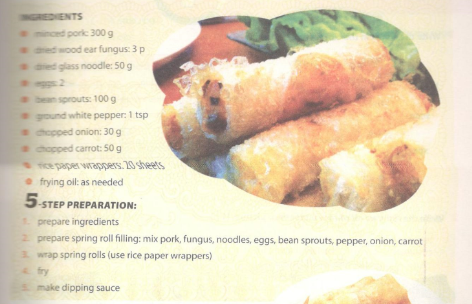
Spring rolls are the perfect dish of the Viet people. Making spring rolls is not so difficult if you know the key steps.
First, ________Finally, enjoy your spring rolls with dipping sauce. It is better to serve them with herbs.
Lời giải chi tiết:
Spring rolls are the perfect dish of the Viet people. Making spring rolls is not so difficult if you know the key steps. First, making the spring rolls start by preparing ingredients according to the list above. Next, prepare spring roll filling by mix together mix pork, fungus, noodles, eggs, bean sprouts, onion and carrot. Also, remember to season with salt, ground black pepper, soy sauce and a pinch of sugar. Next step is to use rice paper wrappers to wrap spring rolls. After frying spring rolls in hot oil for 4-5 minutes until golden brown, it is better to dry on kitchen paper. Finally, enjoy your spring rolls with dipping sauce. It is better to serve them with herbs.
Tạm dịch:
Nem rán là món ăn đặc trưng của người Việt. Để làm nem rán không khó, bạn cần biết các bước sau. Đầu tiên, là công đoạn chuẩn bị nguyên liệu theo công thức đã cho. Sau đó làm nhân nem bằng cách trộn đều thịt băm, miến, trứng gà, đỗ, hành và cà rốt. Đừng quên nêm gia vị gồm muối, hạt tiêu đen, nước mắn và một chút đường. Sau đó dùng vỏ nem để cuộn lại. Sau khi đen chiên với dầu sôi trong khoảng 4-5 phút cho đến khi vàng đều, đặt lên giấy thấm dầu. Cuối cùng, thưởng thức nem cuốn với nước chấm. Ngon hơn khi dùng với rau thơm.

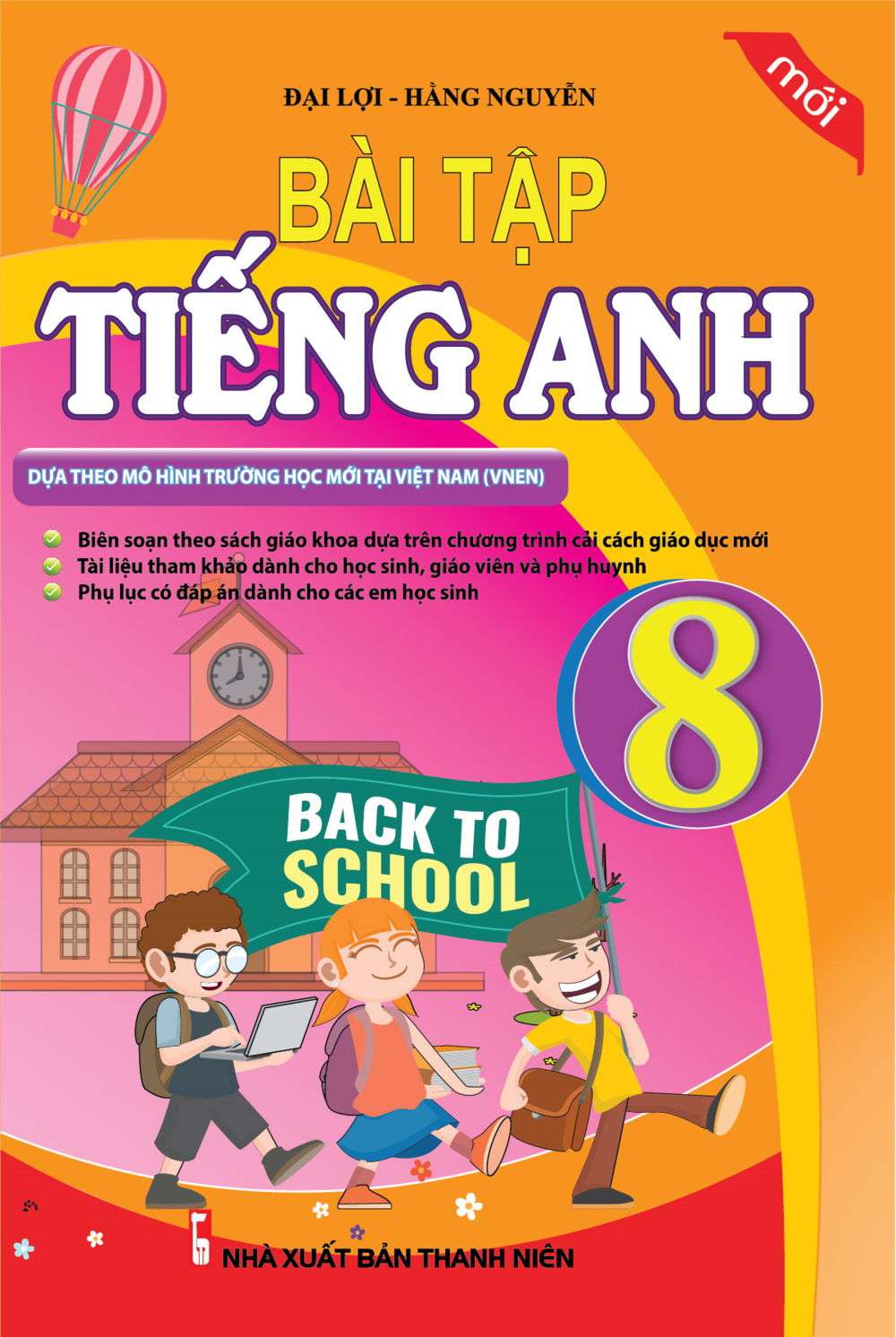

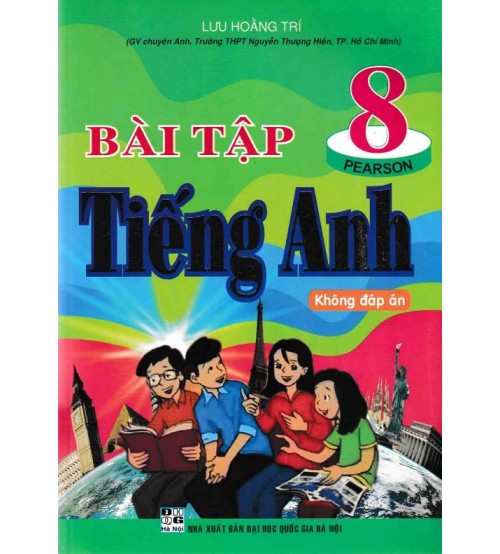



















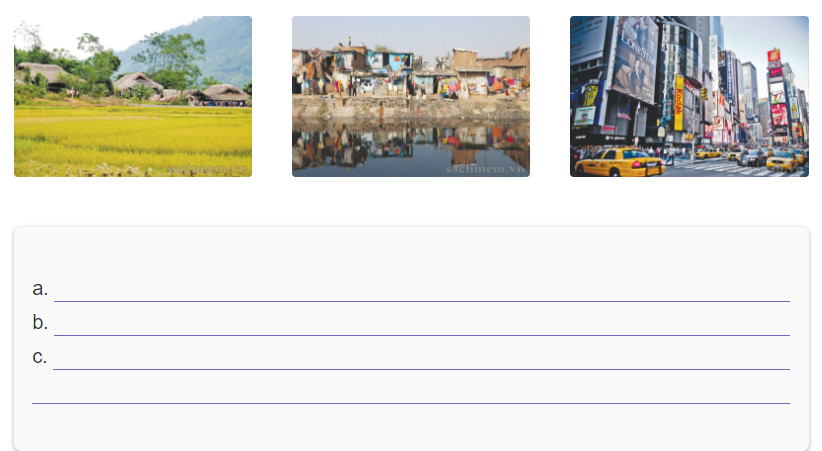

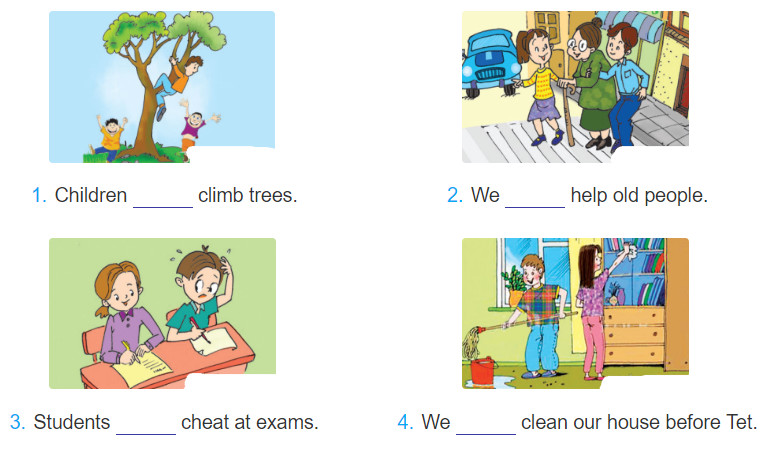

0 Nhận xét